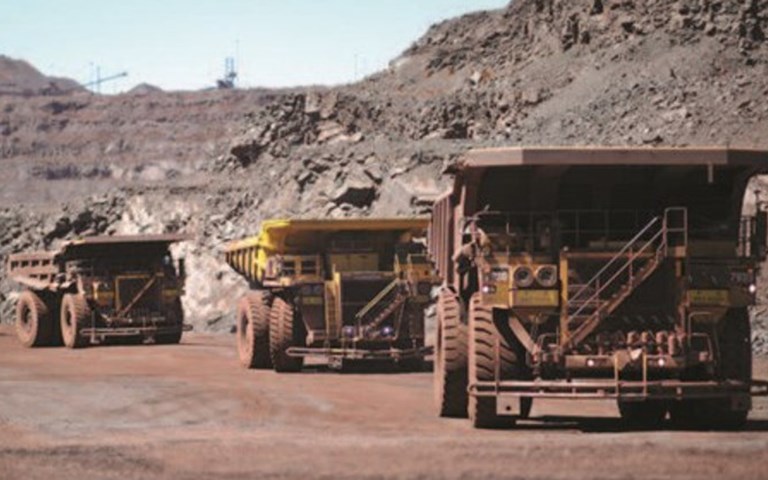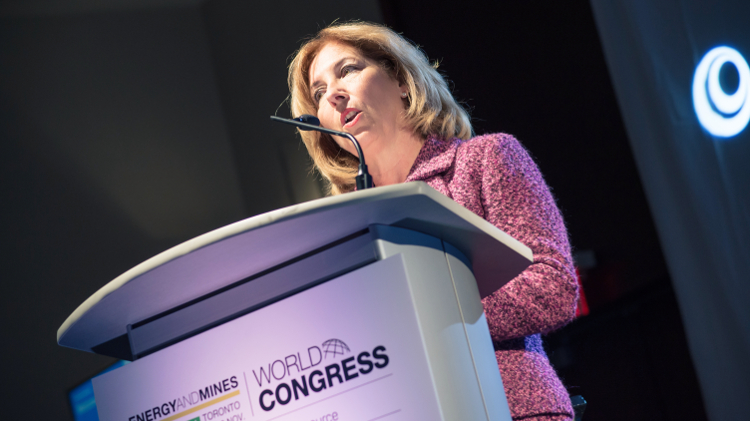At Anglo American's Sishen iron ore operation, waste rock will now only be moved once over the life of the mine and multiple smaller waste rock deposits have been consolidated into "mega deposits" to reduce the number of slopes that will need to be reshaped and rehabilitated at closure | Courtesy of Anglo American
As governments, communities and other stakeholders come to expect and demand a positive environmental and social legacy from mine sites, miners have begun planning for closure even before mines have opened. At Anglo American, a new toolbox is helping change the way the company approaches closure planning. The toolbox – a set of documents with detailed steps cataloguing the many considerations that must be made – affects virtually all levels of the organization, helping guide everything from executive planning to daily site operations.
Rudolph Botha was a senior civil engineer at Anglo American when, around 2005, he and a colleague, Peter Coombes, realized there was a need for understanding the entirety of the closure concept at the company. “Not just the risks,” Botha says, “but the opportunities associated with corporate mine closure planning. We realized that at the work sites, the guys don’t always see that as an integrated approach.” Engineers, for example, would look at physical closure, while environmental people focused on the biophysical aspects. Nobody looked at the task holistically.
Botha, now the company’s lead on mine closure in its technical and sustainability team, and Coombes, the previous head of environment in the technical division, saw an opportunity to improve the process. “We tried to keep it as simple as possible and develop something for the practitioners at a site level that can take the high-level concepts and make them a reality, and change the way we operate,” explains Botha. Equally important was providing guidance for middle management, so they could understand the various linkages between the many components of mine closure.
The hope was to integrate mine closure planning into the day-to-day life-of-mine planning, and by doing so, actually eliminate future closure actions. Even Botha is impressed by their success since implementation. “It’s amazing how many times we can actually eliminate a closure liability completely just by changing the way that we operate.” At their Venetia mine, for example, updated closure plans will reduce the end-of-life liability by roughly 30 per cent. By integrating the closure requirements in the life-of-mine plans at this facility, Anglo American was able to alter its waste rock deposition strategy, minimizing large-scale future closure liabilities. The influence of the toolbox on planning, water management, and biodiversity strategies also created long-term savings.
Integrated approach
Effective as it is, the toolbox is also simple to use. The documents walk the planner through three tools in sequence. In the first tool, strategic planning, basic expectations are identified, baseline knowledge is gathered, and a specific post-closure vision is identified (although that vision may change over time).
The second tool, rapid assessment, contains a comprehensive spreadsheet to allow the practitioner to identify knowledge gaps in the existing mine closure plan. It defines the level of detail that the closure plan should contain for each item to be addressed – including waste disposal facilities, open pit areas, protected habitats and ecosystems, topography and visual impacts, employees and their dependents, and affected and interested parties – based on the remaining mine life.
Finally, tool three directs the practitioner as to how to close the gaps in the existing closure plan, in terms of approach, technology and resources needed for each item identified by tool two. Throughout the toolbox, detailed criteria are specified for each item, allowing rapid evaluation and specific instructions for improvement.
A key approach the toolbox takes is to integrate the four major components of closure – physical, biophysical, social and economic – and to make sure an operator on site looks at all the components simultaneously, rather than just focusing on his or her area of expertise. Progressing to a high level on physical closure without consulting on the social aspect, for example, would lead to a low level of confidence in the overall plan, according to the toolbox.
“It forces, at an operational level, all of the systems to be engaged to achieve the level of confidence you need, depending on your remaining life-of-mine,” says Botha. And by specifying the actions needed to close the gaps in a closure plan, the toolbox requires on-site practitioners to speak to each other and allows them to understand the impact that one group will have on another. The waste rock deposition strategies developed at Venetia and Sishen, for example, required changes to day-to-day operations but will allow the company to move the rock once, rather than twice, over the life of the mine. By consolidating various smaller waste rock deposits into bigger “mega-deposits” at Sishen, fewer slopes will need to be reshaped and rehabilitated at closure. Besides saving money, faster rehabilitation will improve environmental conditions and make local communities happier. The company’s post-closure period may also be reduced, since some closure activities have already been completed.
Because the toolbox was developed with input from operations, it has seen remarkable acceptance within Anglo American in a short period of time. More than 15 operational sites were using the toolbox even before it formally launched in 2008. “It didn’t take us a lot of time to convince people to use it,” Botha says. In presentations, the developers simply laid out the business case for closure planning. “The guys needed the detailed guidance on making better decisions. The tool sells itself.”
Social engagement opportunities
Perhaps the area with the greatest potential upside is improved community relationships. “Social closure, in my mind, is one of the biggest challenges we’ve got in the mining industry,” Botha says. “Physical closure we can handle. We’ve got a lot of good engineers out there. Biophysical elements are controllable; there are a lot of good scientists out there. On the social side, I think we’re still learning, and certainly it’s a key component.”
The requirements of tool three, which closes the gaps in a closure plan, actually help improve collaboration and engagement at the social level by specifying that practitioners consult with various interested and affected parties. “That means you’re building trust in the communities in which you operate,” explains Botha. “Because of the toolbox, it’s more clear what we’re trying to achieve. It increases the confidence you have in your plan. And the definition of consultation is very specific.
“Basically, we want to get to the point where the communities and the people left in the area will take ownership of the closure plan. The concept of the toolbox is that the closure vision should belong to the people who will remain in the area post-closure, because they will be there, and we won’t.”
Set it free
Although they spent around US$1 million over a five-year period developing the toolbox – a bargain, considering the improved operational efficiency and reduced end-of-life liability at their numerous mines – Anglo American has recently released the toolbox publicly for any mining company to use. Perhaps surprisingly, it does not seem that many companies have anything like it. “The level of detail and additional guidance we provide in the toolbox itself, I haven’t seen anything similar to that,” Botha says.
Botha is eager to point out that the toolbox has value for currently operating mines, not just those in early planning stages. “A lot of operations have a lot of life-of-mine left, so they could start as a brownfield site, implement the toolbox, and then be in line with the requirements two to three years later,” he says.
“Hopefully industry will take this on and use it,” he adds. “There is enough flexibility within the toolbox itself not to constrain anybody by using some good practices at their own operational level. Hopefully we can all plan better, design better, and manage operations better, and in doing so, improve the overall legacy for mining as a whole. It has certainly added a lot of value for us.”




